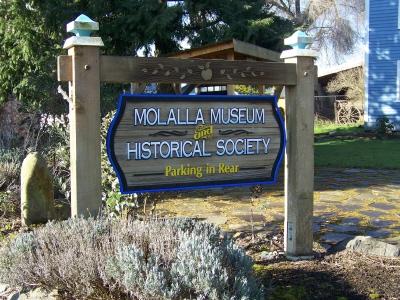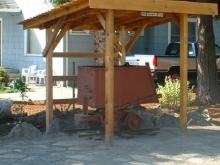Dibble House
Story by Gail J. McCormick, from "Pioneers"
The pride of the Molalla Historical Society is the Dibble House. To the undeveloped historian, it might seem to be so simple a home as to not be interesting. Such was the case when I first saw the Dibble House about eight years ago. But since that time, as I have inquired and learned more of the history of Oregon, I realized the Dibble House is perhaps one of the best preserved and furnished historical dwellings in our area. The dwelling and furnishings typify so well the early settlers' life. Most were not wealthy, but had precious belongings that they cherished.
The Dibbles crossed the Oregon Trail in 1852. Traveling along with Horace and Julia Ann Sturges Dibble were their three children: Eliza Emily, 6; Fayette, 4 and Roswell, babe in arms.
The journey, known for its difficulty, was especially hard on the Dibbles. On the trip, Eliza was bitten on the leg by a rattlesnake. Her leg never grew properly and it always prevented her from walking and running normally. Upon their arrival in Oregon, the Dibbles initially settled in the Needy area. One day, Horace took a ride to look for lost cattle. His quest led him south of the Four Corners where he came upon a little knoll.
Horace immediately fell in love with the spot and wanted it for a homesite. He inquired as to who owned the property. After finding the owner to be Rachel Larkins, he bought the land and planned the building of a home. The year was 1854. Now, since carpenters were much in demand at the time and money was scare, Horace offered a carpenter 320 acres of land to build his home. It was built in the saltbox style, common in New England, but rarely seen in Oregon. Built of fir and cedar, the house is sturdy and well constructed. It has two stories and contains more windows than the average dwelling. As of the time, the fir floors were placed using square nails and the thresholds are several inches lower than the floors because of the many footsteps that have crossed over them through the years.
WARM AND COZY
My favorite room is the cozy bedroom-sitting room immediately off the kitchen. Easily envisioned is Julia Dibble knitting or rocking a baby in this room. The small room contains a brick fireplace, one of two in the home. Originally, the house was heated by these two fireplaces and the kitchen woodstove. Both downstairs bedrooms contain rope spring beds topped with fancy hand-pieced quilts.
The kitchen is furnished with a long table and eight chairs from the Aurora Colony period. A wood cookstove, an enormous pie safe and the usual dry sink used by housewives of that day accompany the calico-covered table. A narrow stairwell leads to the upstairs where Julia Dibble kept a loom on which she made rag carpets that were sold to neighbors.
INDIANS LOVED APPLES
The Dibbles planted apple trees, some still producing today. In the mid-1800's a small orchard was a real treat, and as the fruit matured and ripened, settlers and Indians alike came to buy apples. Excess apples were stored on shelves in the cellar and the late Ina Dibble related an amusing story about the apples. It seems that Beaver Trapper and other Molala Indians came in the spring for apples. Horace Dibble told them he had apples left in the cellar, but they were soft and some spoiled. The Indians' idea of a good apple was not the same as the pioneers. They took the apples and munched with gusto, happily leaving far with gunny sacks of apples tossed over their backs.
APPLE FESTIVAL
In 1975, the Molalla Historical Society voted to initiate a yearly celebration of the apple harvest. The popular event, is held every year the second weekend in October. The community's best pie bakers furnish pies. There's ice cream to accommodate the pies and all sorts of other apple treats, including fresh apple cider.
Pioneer-era crafters display their skills. Demonstrations of spinning, weaving, candle making, soup making and bread making are demonstrated--and yes, one can even find out how to make an apple-head doll. Old-timers are on hand to demonstrate pressing apple cider and how to make hand-churned butter. The two fund-raisers that the Molalla Historical Society has is the Apple Festival and a Mother's Day Quilt show in May. The money raised is used to support the Dibble and the Vonder Ahe houses.
LATER YEARS
The Dibble story ends happily. For many, many years, the Dibbles were part of the Molalla community. They had five more children: Thomas Leroy, Myra Sylvinia, Jesse Morton, Annie Florinda and Walter Perry. Eliza went on the marry A.J. Sawtell, the teasel farmer, and became an expert seamstress. Roswell went on to marry Jett Milster from Silverton. For many years they lived on Warrick Road near Molalla.
Thomas Dibble married Marian Long and bought land near Russellville. He was a farmer and logger. They had two children, Guy and Ina. They were well-know locally as a musical family. The Dibble Orchestra played for many local celebrations. Ina is fondly remembered by old-timers in the Molall area. She never married after losing her sweetheart to World War I.
A small twig table in a heart-shape design, given to Ina by her sweetheart, is on display at the Dibble House. For years, Ina lived alone, but claimed to never be lonely. She had a simple life and her special love was music. She played the dulcimer for all who would listen. Myra married twice--to William H. Lews and Arthur Kayler. Annie married John K. Wilson and moved the Molalla area.
Walter lived with his mother until her death and then moved from the Molalla area. Fayette died when she was 20.
Click any thumbnail image to view a slideshow



